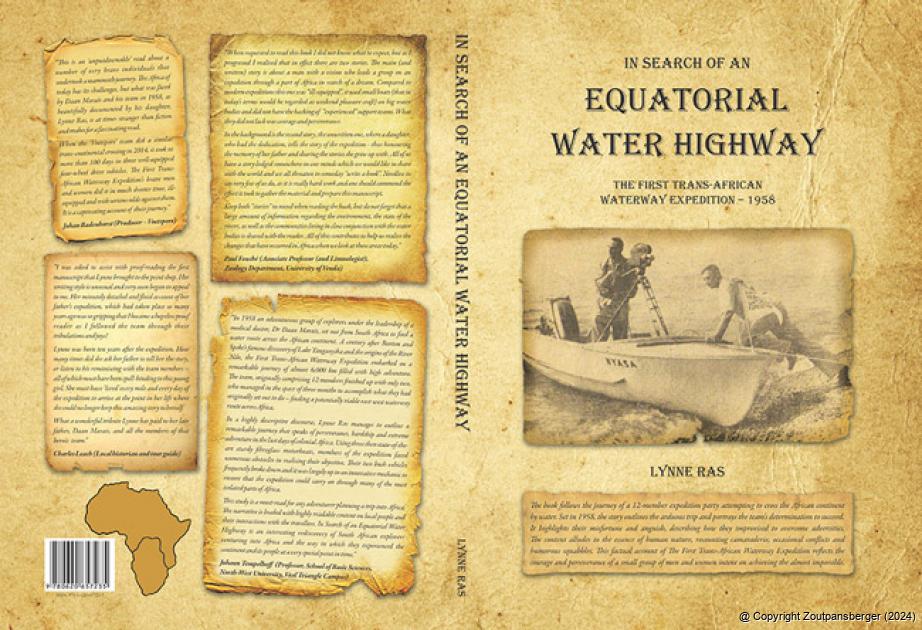

ADVERTISEMENT:

The book, entitled In search of an Equatorial Water Highway, follows the journey of a 12-member expedition party, led by Dr Marais, attempting to cross the African continent by water. Set in 1958, the story outlines the arduous trip and portrays the team’s determination to succeed.
A daughter’s tribute to an adventurous father
Date: 20 August 2015 By: Andries van Zyl
As a tribute to her late father, Dr Daan Marais' daughter Lynne Ras (née Marais) will be releasing a book detailing her father’s adventurous Trans-African Waterway Expedition, the first ever to be undertaken, this coming Friday.
The book, entitled In search of an Equatorial Water Highway, follows the journey of a 12-member expedition party, led by Dr Marais, attempting to cross the African continent by water. Set in 1958, the story outlines the arduous trip and portrays the team’s determination to succeed. It highlights their misfortune and anguish, describing how they improvised to overcome adversities. “The content alludes to the essence of human nature, recounting camaraderie, occasional conflicts and humorous squabbles. This factual account of the first trans-African waterway expedition reflects the courage and perseverance of a small group of men and women intent on achieving the almost impossible,” says author Lynne.
The Trans-African Waterway Expedition set out on 1 June 1958 from the port of Chinde, in the Zambezi estuary on the Indian Ocean, to pioneer and charter a 3,600 mile (5,794 km) inland journey via navigable bodies of water. They reached the Atlantic Ocean at Banana Point in the mouth of the Congo River on 23 August 1958.
Led by Dr Marais, the primary purpose of this expedition was to survey the route to determine the potential development of an equatorial water highway, providing arterial links for commerce and industry between the two oceans. The secondary objective was to study and collect scientific specimens, particularly within the fields of parasitology, ornithology and anthropology.
Representing diverse scientific disciplines, the 12-person team carried the approval of various organisations, including the Council for Scientific and Industrial Research (CSIR), the South African Institute for Medical Research (SAIMR) and an international body of scientists. Expedition members were requested to collect data and document significant findings en route, in exchange for assistance and technical support from the scientific establishments. They were also expected to provide biological and ethnical recordings and studies, as well as rare biological specimens, to museums and international research institutions.
Using three specifically designed 15-foot (4.6 m) fibreglass boats, they crossed the equator twice via three lakes and seven major rivers. An overland party with two support vehicles transported equipment, provisions and fuel and provided portage over impassable areas.
The team returned with valuable scientific data and specimens, along with important acquisitions of primitive art forms obtained from all territories visited. The expedition took 84 days to complete and in total the waterborne party travelled 3,600 miles (5,794 km) between the port of Chinde on the Indian Ocean and Banana Point on the Atlantic Ocean. The boats were hauled overland for a distance of approximately 200 miles (322 km). They established that, by constructing 240 miles (386 km) of locks and canals between Lake Nyasa and Lake Tanganyika, a transcontinental passage for vessels of modest burden might be possible in the future. The group took close to 1,300 photographs and shot more than 30,000 feet (9,144 m) of film. The South African Academy for Science and Art awarded the prestigious Eugène Nielen Marais Commemorative Medal to Daan in 1995, in honour of the expedition.
The late Dr Marais, a well-known resident of the Soutpansberg, passed away on 21 August 2012 in the Limpopo Mediclinic in Polokwane. Aged 83, Marais died from heart failure, five days after undergoing hip surgery. The launch of the book on Friday, 21 August, will not only coincide with the commemoration of his death in 2012, but also with the completion of the expedition on 23 August 1958. “I often put myself in their shoes and imagine how difficult it must have been without modern-day technology – no ATMs, Internet, GPS or cellular and satellite phones. Today’s vehicles are more advanced and travel conditions have improved dramatically,” says Lynne.
The book will be available at Leach Printers in Louis Trichardt from Friday, 21 August. Alternatively, phone author Lynne at Tel 083 302 1408, or send her an email at [email protected]
Viewed: 1722
|
|
Tweet |

-

Former Triegie’s acting career taking off
12 April 2024 By Karla van Zyl -

'Temporary fix is safe, but do not touch cables,' says municipality
12 April 2024 By Andries van Zyl -

Another R2 million pumped into broken pool
12 April 2024 By Andries van Zyl -

Louis Trichardt se rugbymanne wys reeds vroeg in die seisoen tande
12 April 2024 By Andries van Zyl -

Havinga waarsku teen koue en droë winter
11 April 2024 By Andries van Zyl

Andries van Zyl
Andries joined the Zoutpansberger and Limpopo Mirror in April 1993 as a darkroom assistant. Within a couple of months he moved over to the production side of the newspaper and eventually doubled as a reporter. In 1995 he left the newspaper group and travelled overseas for a couple of months. In 1996, Andries rejoined the Zoutpansberger as a reporter. In August 2002, he was appointed as News Editor of the Zoutpansberger, a position he holds until today.

More photos...

ADVERTISEMENT


-

Park development leaves residents puzzled
22 March 2024 By Andries van Zyl -

Local para-athletes shine at SA Champs
05 April 2024 -

Epic finish for local cycling duo
29 March 2024 By Andries van Zyl -

What next Vhembe!
22 March 2024 By Andries van Zyl -

Debt-collection company apologises for rude letter
29 March 2024 By Anton van Zyl

ADVERTISEMENT:


ADVERTISEMENT


